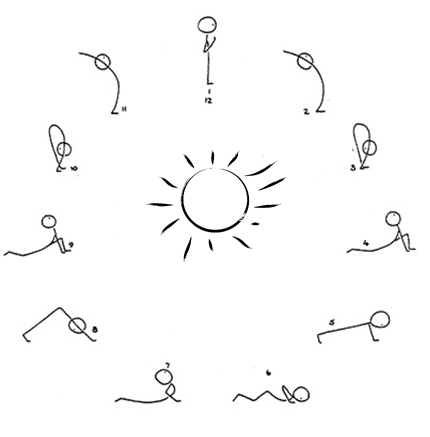Yoga is derived from the Sanskrit root word ‘yuj’ which means ‘join’ or ‘unite’. It’s the union of body, mind and soul.
Health is a positive notion. Positive health is a jubilant and energetic feeling of well-being, resulting in freedom from illness and disease. Yoga is a method, a holistic system that aids in enhancing positivity and wellness of a person. It helps in developing strength, stamina, endurance and high energy at physical level. It also empowers oneself with increased concentration, calm, peace and contentment mentally, leading to inner and outer harmony.
There are various techniques to follow and perform – Pranayama (breathing), Asana (postures), Kriya (cleansing), Dhyana (meditation), and other higher forms of practice. Each of these can be performed at various levels, for starters, we will look at simple steps that’s easy and doable daily.
Pranayama – A breathing technique that focuses on increased oxygen inhalation and carbon-di-oxide exhalation. There are three phases of Pranayama – puraka, rechaka and kumbhaka. Puraka is controlled inhalation; rechaka is controlled exhalation and kumbhaka is controlled retention of breath. It is said that an average person uses only 30% of the lungs’ capacity. This can easily be doubled by practicing Pranayama; sustained long-term practice can improve furthermore. This internal cleansing increases positivity / mental wellbeing and lowers blood-pressure.
Asana – Postures, that help in keeping body fit and to develop strength, flexibility and balance. Asanas number in hundreds – each one with specific purpose to gives stability and comfort, both at physical and mental level. Regular practice of Asanas are believed to help the heart and eliminate diseases caused by being sedentary and unhealthy lifestyle choices.
The most commonly performed set of asanas is Surya Namaskar (sun-salutation). These are detailed here below, Page 2 onwards.
Kriya – means Action, directed at specific organs of the body that cleanses and detoxifies each of them. Shatakarma, or six cleansing processes (viz, Neti, Dhauti, Basti, Trataka, Nauli, Kapalabhati and Agnisara) using air, water and the organs themselves as a tool. Kriya requires to be practiced after obtaining training from a learned Guru, an expert in yogic practices.
Dhyana – means concentration; to increase awareness and strength of the mind by focusing one’s thought. By concentrating on one point, regularly, the mind is trained to be stable, eliminate negative emotions like fear, anger, depression, anxiety, and increase clarity of thought and will-power.
Surya Namaskar or Sun Salutation is a set of 12 powerful yoga asanas (postures) which is a great workout method, an excellent way to stay fit. All you need is willing mind and a mat!
Ideally done at sunrise, facing east, these asanas can be done at your own pace, each with its own benefit. The 3-speed variations can help you get optimum benefits of Surya Namaskar:
Slow pace : to stay fit and keep the body flexible
Medium pace : useful for toning your muscles and improve metabolism
Fast pace : an excellent cardiovascular workout and aids in weight loss
Now let’s learn the Surya Namaskar –
| 1. Pranamasana Om Mitraya Namaha | The Prayer Pose Pranamasana is the start of Surya Namaskar. Join your feet and stand upright balancing your weight equally on both feet. Bring your palms in front and combine so that they touch your chest. Close your eyes. And let your body relax. While you inhale, raise your arms from the sides. And as you exhale, join your palms together in front of your chest as in praying. This is the Pratham Namaskar or first salutation towards the sun. Relaxes body and mind. |
| 2. Hastauttanasana Om Ravayé Namaha | The Raised Arms Pose Keeping the palms joined in the previous prayer position, breathe in and lift your arms up and bend backwards slightly. Arms shoulder-wide apart. This posture is to loosen up by stretching the entire body. Stretches the chest and abdomen, lifts energy up through the body. |
| 3. Padahastasana Om Suryāya Namaha | The Hand-to-Foot Pose While standing upright, breathe out, and bend forward from the waist. Go down and touch the ground but keeping your spine straight as much as possible. Do this as your exhale slowly and completely. Massages abdomen, increases digestive power and blood flow to brain, stretches spine, thigh muscles |
| 4. Ashwa Sanchalanasana Om Bhānavé Namaha | The Equestrian Pose Now breathe in, and stretch your body parallely to the ground. Keep your hands to the side, and bring your right knee towards the right part of the chest and let your left leg stretch behind. Look up. Stretches quadriceps, pelvic muscles and spine, stimulates abdominal organs, increases mental prowess |
| 5. Dandasana Om Khagāya Namaha | The Stick Pose As your inhale, fling your right leg also backwards aligning your entire body parallely to the ground. Improves posture, strengthens back muscles and spine, stretches shoulders and chest. |
| 6. Ashtanga Namaskara Om Pūshné Namaha | The Eight point salute Stay in Dandasana, gently bring down your knees towards the floor and exhale. Now bring your chin to rest on the floor, keep your hips elevated in the air. Hence, your eight parts (two hands, two knees, chin and chest will rest on the floor while your hip stays elevated in the air). Develops the chest, and strengthens arms and legs. |
| 7. Bhujangasana Om Hiranya Garbhāya Namaha | The Cobra pose. This is simply aligning your chest and torso 90 degrees to the ground, keeping your legs and mid-section flat on the ground. Make sure you use your hands to support your body and are not tempted to transfer your entire weight onto them. Relieves tension in back and spine, stimulates and expands chest and conditions abdominal organs |
| 8. Parvatasana Om Marichaye Namaha | The Mountain Pose Keep your palm and feet where they are, and slowly raise your mid-section – hips and abdomen. Breathe out as you stretch your legs, spine and arms. Strengthens legs and arms, stretches calf and spine muscles, and relieves varicose veins. |
| 9. Ashwa Sanchalanasana Om Ādityāya Namaha | The Equestrian Pose Now from Parvatasana, return to the ashwa sanchalanasana. But this time, we do the opposite of what we did in the 4th step. Procedure- Bring your right foot forward, while resting the left foot behind, at its original position. Stretches quadriceps, pelvic muscles and spine, stimulates abdominal organs, increases mental prowess |
| 10. Pada hastasana Om Savitré Namaha | The Hand to foot pose Now slowly bring your left foot forward, next to the right foot as you exhale. Keeping the position of your hands intact, lift yourself up to slowly enter Hasta Padasana. Massages abdomen, increases digestive power, blood flow to brain, stretches spine. |
| 11. Hastauttanasana Om Ārkāya Namaha | The Raised Arms Pose Now inhale, raise your hands upward, and bend backward to enter Ardha Chakra Asana, or Hasta-Uttana asana. Massages abdomen, increases digestive power, blood flow to brain, stretches spine. |
| 12. Pranamasana Om Bhaskarāya Namaha | The Prayer Pose Finally, exhale and stand in a relaxed manner in the namaskara mudra. Feel the positive vibrations in your body. |
This is one set of Surya Namaskar Asanas – best done outdoors, early morning. Ass you can see, each asana has a mantra for the Sun; chanting of the mantra is said to be beneficial, though, is optional.
Twelve repetitions of this holistic exercise are said to yield maximum benefit, i.e., build strength and increase flexibility. Researchers estimate that 30 mins of Suryanamaskar can burn ~400 calories!
Resting after 6 sets, in sukhasana (sitting down cross-legged) is advised for people with poor fitness and elderly. People with any medical condition may consult a doctor before starting to do brisk yoga asanas / surya namaskar.

